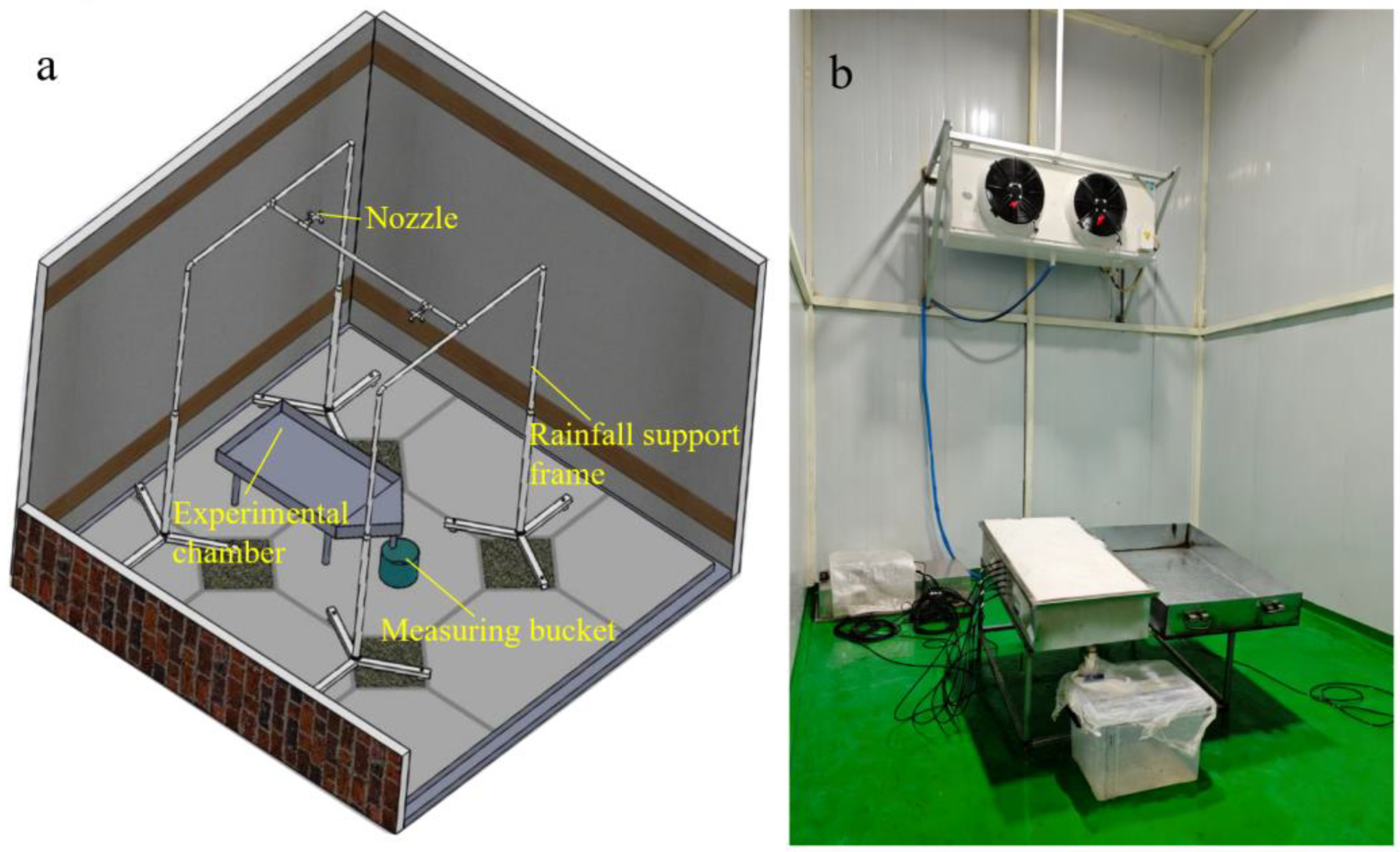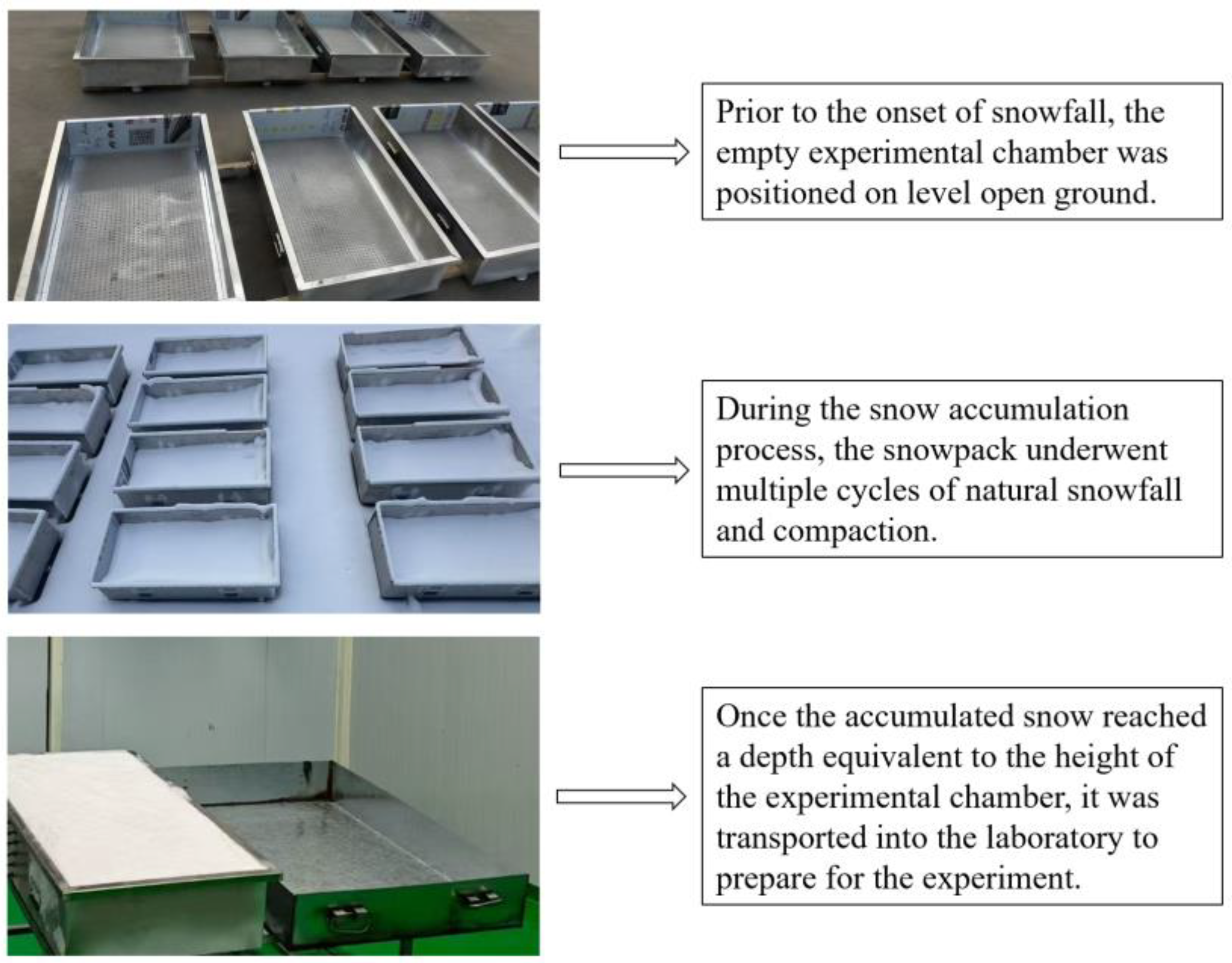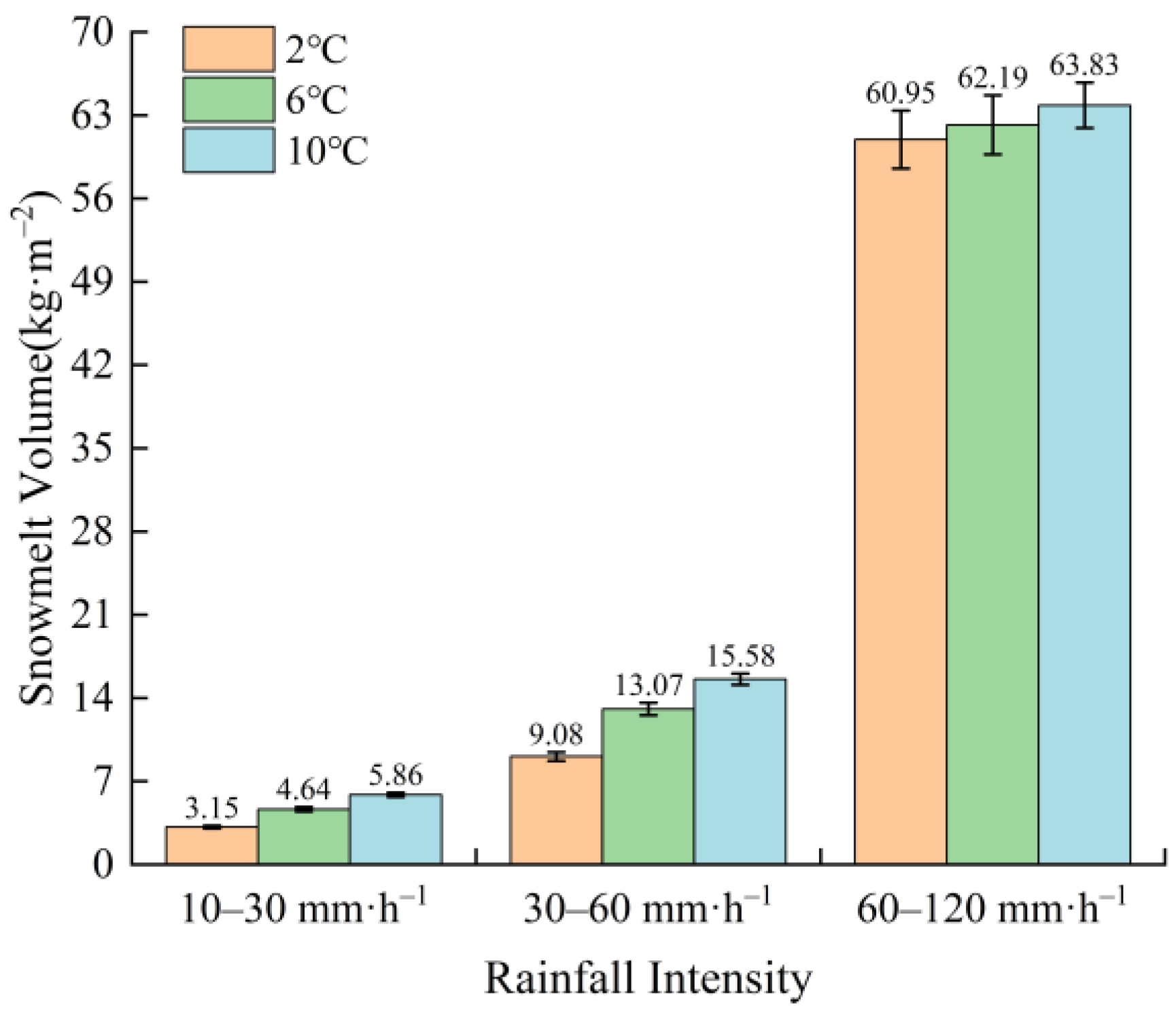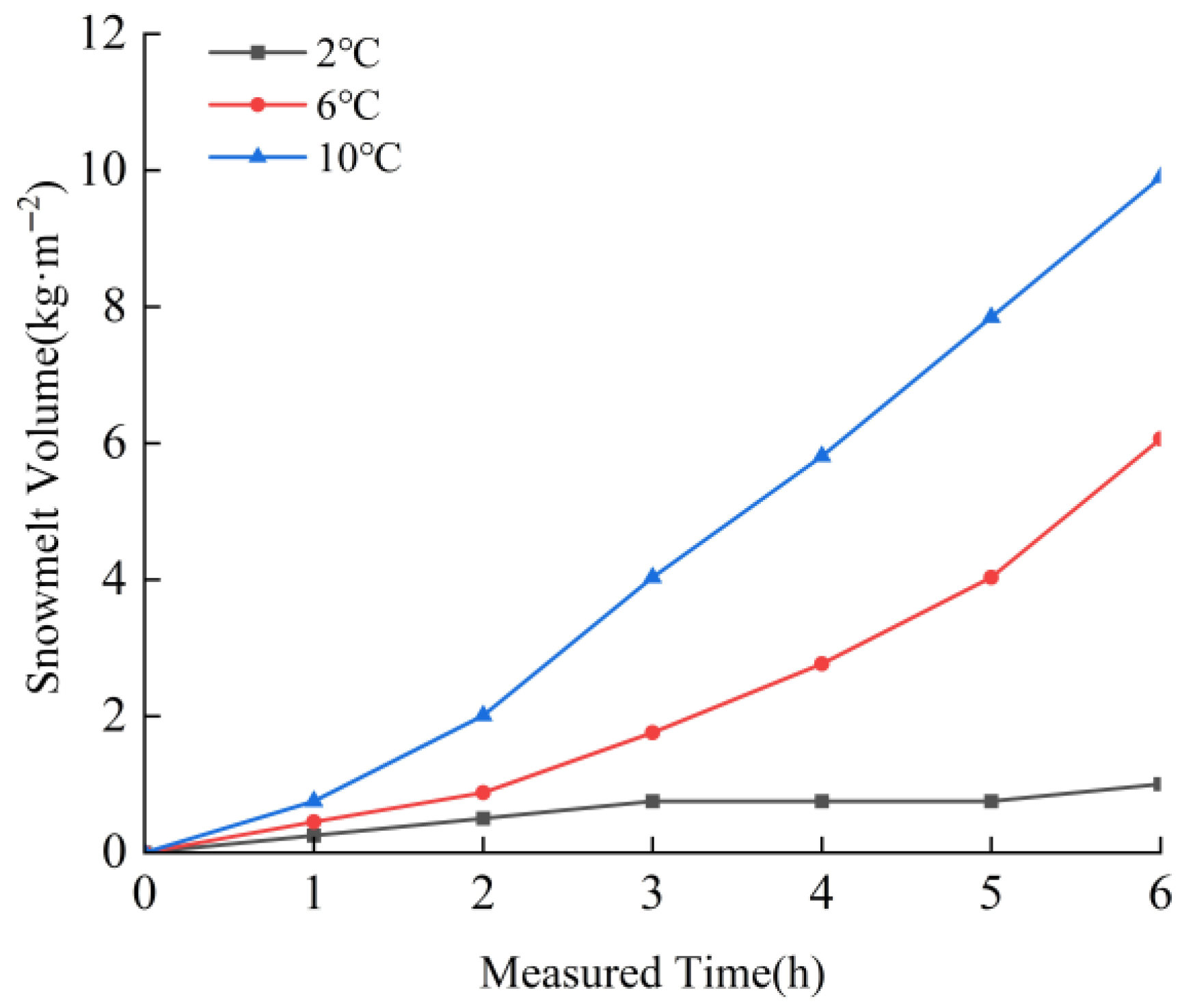Snowmelt Volume from Rain-on-Snow Events Under Controlled Temperature and Rainfall: A Laboratory Experimental Study
Abstract
1. Introduction
2. Materials and Methods
2.1. Experimental Setup
2.2. Experimental Parameters
2.2.1. Temperature
2.2.2. Rainfall Intensity
2.2.3. Rainfall Duration
2.3. Experimental Protocol
3. Results
3.1. Temperature Rise Increases Snowmelt Volume During ROS Events
- Under a rainfall intensity of 10–30 mm·h−1, snowmelt volumes were 3.15 kg·m−2 at 2 °C, 4.64 kg·m−2 at 6 °C, and 5.86 kg·m−2 at 10 °C. The volume at 10 °C was approximately 1.86 times that at 2 °C.
- Under a rainfall intensity of 30–60 mm·h−1, snowmelt volumes were 9.08 kg·m−2, 13.07 kg·m−2, and 15.58 kg·m−2 at 2 °C, 6 °C, and 10 °C, respectively. The volume at 10 °C was about 1.72 times that at 2 °C.
- Under a rainfall intensity of 60–120 mm·h−1, the corresponding snowmelt volumes were 60.95 kg·m−2, 62.19 kg·m−2, and 63.83 kg·m−2, respectively, from low to high. The latter snowmelt volume was only about 1.05 times that of the former.
- Under a rainfall intensity of 10–30 mm·h−1 (Figure 5a), the 40 min post-rainfall snowmelt volumes were 2.02 kg·m−2, 2.63 kg·m−2, and 3.09 kg·m−2 at 2 °C, 6 °C, and 10 °C, respectively. The increase in snowmelt volume attributable to rising temperature was 1.07 kg·m−2.
- Under a rainfall intensity of 30–60 mm·h−1 (Figure 5b), the post-rainfall snowmelt volumes were 3.53 kg·m−2, 3.94 kg·m−2, and 4.14 kg·m−2, respectively, with temperature causing an increase of 0.61 kg·m−2 in snowmelt volume.
- Under a rainfall intensity of 60–120 mm·h−1 (Figure 5c), the post-rainfall snowmelt volumes were 10.83 kg·m−2, 10.89 kg·m−2, and 11.12 kg·m−2, showing a negligible increase of only 0.29 kg·m−2.
3.2. Increased Rainfall Intensity Significantly Enhances Snowmelt Volume During ROS Events
- At 2 °C, the snowmelt volume under 30–60 mm·h−1 rainfall was about 2.88 times that under 10–30 mm·h−1, while the volume under 60–120 mm·h−1 rainfall was around 6.68 times that under 30–60 mm·h−1.
- At 6 °C, the 30–60 mm·h−1 rainfall snowmelt volume was around 2.82 times the 10–30 mm·h−1 rainfall volume, and the 60–120 mm·h−1 rainfall volume was about 4.76 times the 30–60 mm·h−1 rainfall volume.
- At 10 °C, the snowmelt volume under 30–60 mm·h−1 rainfall was approximately 2.66 times that under 10–30 mm·h−1, and the volume under 60–120 mm·h−1 rainfall was about 4.10 times that under 30–60 mm·h−1.
- At 2 °C (Figure 6a), during the 20 min rainfall period, the snowmelt volume under 60–120 mm·h−1 rainfall was approximately 43.35 times and 8.03 times greater than that under 10–30 mm·h−1 and 30–60 mm·h−1 rainfall, respectively.
- At 6 °C (Figure 6b), the snowmelt volume under 60–120 mm·h−1 rainfall was around 24.52 times and 4.62 times greater than that under 10–30 mm·h−1 and 30–60 mm·h−1 rainfall, respectively.
- At 10 °C (Figure 6c), the snowmelt volume under 60–120 mm·h−1 rainfall showed an approximate increase of 18.03 times and 3.61 times relative to that under 10–30 mm·h−1 and 30–60 mm·h−1 rainfall, respectively.
- At 2 °C (Figure 6a), the cumulative snowmelt volumes over the total 1 h period (rain and post-rain) for rainfall intensities of 10–30, 30–60, and 60–120 mm·h−1 increased by 179%, 64%, and 22%, respectively, compared to the volumes measured at rainfall cessation.
- Similarly, at 6 °C (Figure 6b), the corresponding increases in snowmelt volume were 131%, 43%, and 21%, respectively.
- At 10 °C (Figure 6c), the increases were 112%, 36%, and 21% for the respective rainfall intensities.
3.3. Snowmelt Volume During ROS Events Increases with Prolonged Rainfall Duration
- Under a rainfall intensity of 10–30 mm·h−1, as rainfall duration increased from 20 min to 60 min to 120 min, snowmelt volumes rose from 4.64 kg·m−2 to 21.35 kg·m−2 to 46.41 kg·m−2, representing an average increase of approximately 0.42 kg·m−2 per minute, and an increase from 4.64 to 46.41 is 10-fold.
- Under a rainfall intensity of 30–60 mm·h−1, snowmelt volumes increased to 13.07, 52.71, and 102.76 kg·m−2 with increasing duration, increasing at an average rate of about 0.90 kg·m−2 per minute, and an increase from 13.07 to 102.76 is 7.86-fold.
- Under a rainfall intensity of 60–120 mm·h−1, the snowmelt volumes corresponding to different rainfall durations were 62.19 kg·m−2, 172.62 kg·m−2, and 331.12 kg·m−2, respectively, showing an average increase rate of approximately 2.69 kg·m−2 per minute, and an increase from 62.19 to 331.12 is 5.32-fold.
- Under a rainfall intensity of 10–30 mm·h−1 (Figure 8a), the snowmelt volume for a 120 min duration was approximately 20.82 times that for a 20 min duration. Similarly, the snowmelt volume generated during the 40 min post-rainfall period for the 120 min event was about 1.74 times that for the 20 min event.
- Under a rainfall intensity of 30–60 mm·h−1 (Figure 8b), the snowmelt volume for 120 min was approximately 10.61 times that for 20 min, while the post-rainfall snowmelt volume for 120 min was about 1.49 times that for 20 min.
- Under a rainfall intensity of 60–120 mm·h−1 (Figure 8c), the snowmelt volume for 120 min was approximately 6.21 times that for 20 min, whereas the post-rainfall snowmelt volume for the former was only around 1.14 times that of the latter.
3.4. The Snowmelt-to-Rainfall Ratio Increases with Both Rainfall Intensity and Duration
- Under the 10–30 mm·h−1 intensity, extending the rainfall duration from 20 min to 120 min raised the ratio from 26.46% to 91.83%, an increase of 65.37 percentage points.
- In contrast, for a fixed 20 min rainfall duration, increasing the intensity from 10–30 mm·h−1 to 60–120 mm·h−1 elevated the ratio from 26.46% to 137.91%, an increase of 111.45 percentage points. This intensity-driven increase far exceeds that attributable to duration extension.
3.5. ROS Events Significantly Enhance Total Snowmelt Volume
4. Discussion
5. Conclusions
- (1)
- ROS events significantly accelerate snow ablation rates and promote rapid increases in snowmelt volume compared to temperature-driven melting alone.
- (2)
- Under high-intensity rainfall, snowmelt volume exhibits weaker temperature dependence. Conversely, low-intensity conditions demonstrate greater sensitivity to temperature variations and stronger reliance on ambient temperature. A distinct temperature threshold exists within the 2–6 °C range for snowpacks under low rainfall intensity, and exceeding this threshold accelerates ablation rates and amplifies melt volume.
- (3)
- Rainwater constitutes the primary driver of snowpack ablation during high-intensity ROS events, critically influencing snowmelt generation. When rainfall intensity exceeds 60 mm·h−1, snowmelt volume increases substantially, triggering amplified snowmelt runoff. Additionally, snowpacks exhibit stronger rainwater retention capacity under low-intensity ROS, with this effect becoming more pronounced at lower temperatures.
- (4)
- Snowmelt volume increases with longer rainfall duration across all intensity regimes. The relative enhancement in snowmelt volume per unit time extension is greater under low rainfall intensity. Furthermore, snowmelt generation under low-intensity conditions demonstrates stronger dependence on temporal accumulation effects, while high-intensity rainfall achieves substantial snowmelt volumes rapidly with short-term efficiency.
Author Contributions
Funding
Data Availability Statement
Conflicts of Interest
References
- Nuerlan, H.; Shen, Y. Flood Characteristics of Altay Area, Xinjiang. J. China Hydrol. 2014, 34, 74–81. [Google Scholar]
- Sezen, C.; Šraj, M.; Medved, A.; Bezak, N. Investigation of Rain-On-Snow Floods under Climate Change. Appl. Sci. 2020, 10, 1242. [Google Scholar] [CrossRef]
- Chen, R.; Shen, Y.; Mao, W.; Zhang, S.; Lv, H.; Liu, Y.; Liu, Z.; Fang, S.; Zhang, W.; Chen, C.; et al. Progress and Issues on Key Technologies in Forecasting of Snowmelt Flood Disaster in Arid Areas, Northwest China. Adv. Earth Sci. 2021, 36, 233–244. [Google Scholar] [CrossRef]
- Cui, M.; Zhou, G.; Zhang, D.; Zhang, S. Global snowmelt flood disasters and their impact from 1900 to 2020. J. Glaciol. Geocryol. 2022, 44, 1898–1911. [Google Scholar] [CrossRef]
- Jones, J.A.; Perkins, R.M. Extreme Flood Sensitivity to Snow and Forest Harvest, Western Cascades, Oregon, United States. Water Resour. Res. 2010, 46, 2009WR008632. [Google Scholar] [CrossRef]
- Pradhanang, S.M.; Frei, A.; Zion, M.; Schneiderman, E.M.; Steenhuis, T.S.; Pierson, D. Rain-on-snow Runoff Events in New York. Hydrol. Process. 2013, 27, 3035–3049. [Google Scholar] [CrossRef]
- Li, D.; Lettenmaier, D.P.; Margulis, S.A.; Andreadis, K. The Role of Rain-on-Snow in Flooding Over the Conterminous United States. Water Resour. Res. 2019, 55, 8492–8513. [Google Scholar] [CrossRef]
- Bean, B.L.; Watts, E. Quantifying the Impact of Rain-on-Snow Induced Flooding in the Western United States. Water 2024, 16, 2826. [Google Scholar] [CrossRef]
- Freudiger, D.; Kohn, I.; Stahl, K.; Weiler, M. Large-Scale Analysis of Changing Frequencies of Rain-on-Snow Events with Flood-Generation Potential. Hydrol. Earth Syst. Sci. 2014, 18, 2695–2709. [Google Scholar] [CrossRef]
- Beniston, M.; Stoffel, M. Rain-on-Snow Events, Floods and Climate Change in the Alps: Events May Increase with Warming up to 4 °C and Decrease Thereafter. Sci. Total Environ. 2016, 571, 228–236. [Google Scholar] [CrossRef]
- Dou, T.; Xiao, C.; Liu, J.; Wang, Q.; Pan, S.; Su, J.; Yuan, X.; Ding, M.; Zhang, F.; Xue, K.; et al. Trends and Spatial Variation in Rain-on-Snow Events over the Arctic Ocean during the Early Melt Season. Cryosphere 2021, 15, 883–895. [Google Scholar] [CrossRef]
- Ye, H.; Yang, D.; Robinson, D. Winter Rain on Snow and Its Association with Air Temperature in Northern Eurasia. Hydrol. Process. 2008, 22, 2728–2736. [Google Scholar] [CrossRef]
- Pan, C.G.; Kirchner, P.B.; Kimball, J.S.; Kim, Y.; Du, J. Rain-on-Snow Events in Alaska, Their Frequency and Distribution from Satellite Observations. Environ. Res. Lett. 2018, 13, 075004. [Google Scholar] [CrossRef]
- McCabe, G.J.; Clark, M.P.; Hay, L.E. Rain-on-Snow Events in the Western United States. Bull. Am. Meteorol. Soc. 2007, 88, 319–328. [Google Scholar] [CrossRef]
- Surfleet, C.G.; Tullos, D. Variability in Effect of Climate Change on Rain-on-Snow Peak Flow Events in a Temperate Climate. J. Hydrol. 2013, 479, 24–34. [Google Scholar] [CrossRef]
- Pall, P.; Tallaksen, L.M.; Stordal, F. A Climatology of Rain-on-Snow Events for Norway. J. Clim. 2019, 32, 6995–7016. [Google Scholar] [CrossRef]
- Morán-Tejeda, E.; López-Moreno, J.; Stoffel, M.; Beniston, M. Rain-on-Snow Events in Switzerland: Recent Observations and Projections for the 21st Century. Clim. Res. 2016, 71, 111–125. [Google Scholar] [CrossRef]
- Stoffel, M.; Corona, C. Future Winters Glimpsed in the Alps. Nat. Geosci. 2018, 11, 458–460. [Google Scholar] [CrossRef]
- Sobota, I.; Weckwerth, P.; Grajewski, T. Rain-On-Snow (ROS) Events and Their Relations to Snowpack and Ice Layer Changes on Small Glaciers in Svalbard, the High Arctic. J. Hydrol. 2020, 590, 125279. [Google Scholar] [CrossRef]
- Yang, Z.; Chen, R.; Liu, Y.; Zhao, Y.; Liu, Z.; Liu, J. The Impact of Rain-on-snow Events on the Snowmelt Process: A Field Study. Hydrol. Process. 2023, 37, e15019. [Google Scholar] [CrossRef]
- Hirashima, H.; Avanzi, F.; Yamaguchi, S. Liquid Water Infiltration into a Layered Snowpack: Evaluation of a 3-D Water Transport Model with Laboratory Experiments. Hydrol. Earth Syst. Sci. 2017, 21, 5503–5515. [Google Scholar] [CrossRef]
- Marshall, H.P.; Conway, H.; Rasmussen, L.A. Snow Densification during Rain. Cold Reg. Sci. Technol. 1999, 30, 35–41. [Google Scholar] [CrossRef]
- Rössler, O.; Froidevaux, P.; Börst, U.; Rickli, R.; Martius, O.; Weingartner, R. Retrospective Analysis of a Nonforecasted Rain-on-Snow Flood in the Alps—A Matter of Model Limitations or Unpredictable Nature? Hydrol. Earth Syst. Sci. 2014, 18, 2265–2285. [Google Scholar] [CrossRef]
- Pomeroy, J.W.; Fang, X.; Marks, D.G. The Cold Rain-on-snow Event of June 2013 in the Canadian Rockies—Characteristics and Diagnosis. Hydrol. Process. 2016, 30, 2899–2914. [Google Scholar] [CrossRef]
- Marks, D.; Kimball, J.; Tingey, D.; Link, T. The Sensitivity of Snowmelt Processes to Climate Conditions and Forest Cover during Rain-on-Snow: A Case Study of the 1996 Pacific Northwest Flood. Hydrol. Process. 1998, 12, 1569–1587. [Google Scholar] [CrossRef]
- Baggi, S.; Schweizer, J. Characteristics of Wet-Snow Avalanche Activity: 20 Years of Observations from a High Alpine Valley (Dischma, Switzerland). Nat. Hazards 2009, 50, 97–108. [Google Scholar] [CrossRef]
- Juras, R.; Pavlásek, J.; Vitvar, T.; Šanda, M.; Holub, J.; Jankovec, J.; Linda, M. Isotopic Tracing of the Outflow during Artificial Rain-on-Snow Event. J. Hydrol. 2016, 541, 1145–1154. [Google Scholar] [CrossRef]
- Singh, P.; Spitzbart, G.; Hübl, H.; Weinmeister, H.W. Hydrological Response of Snowpack under Rain-on-Snow Events: A Field Study. J. Hydrol. 1997, 202, 1–20. [Google Scholar] [CrossRef]
- Lee, J.; Feng, X.; Posmentier, E.S.; Faiia, A.M.; Osterhuber, R.; Kirchner, J.W. Modeling of Solute Transport in Snow Using Conservative Tracers and Artificial Rain-on-snow Experiments. Water Resour. Res. 2008, 44, 2006WR005477. [Google Scholar] [CrossRef]
- Lee, J.; Jung, H. Separations of Meltwater Discharge in a Snowpack by Artificial Rain-on-Snow Experiments. Appl. Water Sci. 2024, 14, 248. [Google Scholar] [CrossRef]
- Eiriksson, D.; Whitson, M.; Luce, C.H.; Marshall, H.P.; Bradford, J.; Benner, S.G.; Black, T.; Hetrick, H.; McNamara, J.P. An Evaluation of the Hydrologic Relevance of Lateral Flow in Snow at Hillslope and Catchment Scales. Hydrol. Process. 2013, 27, 640–654. [Google Scholar] [CrossRef]
- Ocampo Melgar, D.; Meza, F.J. Exploring the Fingerprints of Past Rain-on-Snow Events in a Central Andean Mountain Range Basin Using Satellite Imagery. Remote Sens. 2020, 12, 4173. [Google Scholar] [CrossRef]
- Stimberis, J.; Rubin, C.M. Glide Avalanche Response to an Extreme Rain-on-Snow Event, Snoqualmie Pass, Washington, USA. J. Glaciol. 2011, 57, 468–474. [Google Scholar] [CrossRef]
- Nedělčev, O.; Matějka, M.; Láska, K.; Engel, Z.; Kavan, J.; Jenicek, M. The Role of Snowmelt, Glacier Melt and Rainfall in Streamflow Dynamics on James Ross Island, Antarctic Peninsula. Cryosphere 2025, 19, 2457–2473. [Google Scholar] [CrossRef]
- Singhal, P.; Goel, N.K.; Bronstert, A.; Vormoor, K.; Agarwal, A.; Arora, M. Understanding the Flood Seasonality in a Himalayan River Basin under Changing Climate. Theor. Appl. Climatol. 2025, 156, 364. [Google Scholar] [CrossRef]
- Li, B.; Chen, Y.; Chen, Z.; Li, W. The Effect of Climate Change during Snowmelt Period on Streamflow in the Mountainous Areas of Northwest China. Geogr. Sin. 2012, 67, 1461–1470. [Google Scholar]
- Scaff, L.; Krogh, S.A.; Musselman, K.; Harpold, A.; Li, Y.; Lillo-Saavedra, M.; Oyarzún, R.; Rasmussen, R. The Impacts of Changing Winter Warm Spells on Snow Ablation Over Western North America. Water Resour. Res. 2024, 60, e2023WR034492. [Google Scholar] [CrossRef]
- Sanders, M.C.; Cordeira, J.M.; Metz, N.D. Hydrometeorological Characteristics of Ice Jams on the Pemigewasset River in Central New Hampshire. J. Hydrometeorol. 2020, 21, 2923–2942. [Google Scholar] [CrossRef]
- Rücker, A.; Boss, S.; Kirchner, J.W.; Von Freyberg, J. Monitoring Snowpack Outflow Volumes and Their Isotopic Composition to Better Understand Streamflow Generation during Rain-on-Snow Events. Hydrol. Earth Syst. Sci. 2019, 23, 2983–3005. [Google Scholar] [CrossRef]
- Aanes, R.; Sæther, B.; Øritsland, N.A. Fluctuations of an Introduced Population of Svalbard Reindeer: The Effects of Density Dependence and Climatic Variation. Ecography 2000, 23, 437–443. [Google Scholar] [CrossRef]









| Parameter Name | Value | ||
|---|---|---|---|
| Temperature | 2 °C | 6 °C | 10 °C |
| Rainfall Intensity | 10–30 mm·h−1 | 30–60 mm·h−1 | 60–120 mm·h−1 |
| Rainfall Duration | 20 min | 60 min | 120 min |
| Rainfall Intensity | 10–30 mm·h−1 | 30–60 mm·h−1 | 60–120 mm·h−1 | |
|---|---|---|---|---|
| Rainfall Duration | ||||
| 20 min | 26.46% | 62.61% | 137.91% | |
| 60 min | 76.43% | 98.59% | 142.83% | |
| 120 min | 91.83% | 110.28% | 145.79% | |
| Rainfall Conditions | No-Rain Conditions | 10–30 mm·h−1 | 30–60 mm·h−1 | 60–120 mm·h−1 |
|---|---|---|---|---|
| 1 h Snowmelt Volume (kg·m−2) | 0.45 | 17.67 | 47.38 | 161.28 |
| 2 h Snowmelt Volume (kg·m−2) | 0.88 | 41.84 | 96.89 | 318.66 |
Disclaimer/Publisher’s Note: The statements, opinions and data contained in all publications are solely those of the individual author(s) and contributor(s) and not of MDPI and/or the editor(s). MDPI and/or the editor(s) disclaim responsibility for any injury to people or property resulting from any ideas, methods, instructions or products referred to in the content. |
© 2025 by the authors. Licensee MDPI, Basel, Switzerland. This article is an open access article distributed under the terms and conditions of the Creative Commons Attribution (CC BY) license (https://creativecommons.org/licenses/by/4.0/).
Share and Cite
Liu, W.; Hanati, G.; Hu, K.; Danierhan, S.; Jin, L. Snowmelt Volume from Rain-on-Snow Events Under Controlled Temperature and Rainfall: A Laboratory Experimental Study. Hydrology 2025, 12, 305. https://doi.org/10.3390/hydrology12110305
Liu W, Hanati G, Hu K, Danierhan S, Jin L. Snowmelt Volume from Rain-on-Snow Events Under Controlled Temperature and Rainfall: A Laboratory Experimental Study. Hydrology. 2025; 12(11):305. https://doi.org/10.3390/hydrology12110305
Chicago/Turabian StyleLiu, Wenjun, Gulimire Hanati, Keke Hu, Sulitan Danierhan, and Lei Jin. 2025. "Snowmelt Volume from Rain-on-Snow Events Under Controlled Temperature and Rainfall: A Laboratory Experimental Study" Hydrology 12, no. 11: 305. https://doi.org/10.3390/hydrology12110305
APA StyleLiu, W., Hanati, G., Hu, K., Danierhan, S., & Jin, L. (2025). Snowmelt Volume from Rain-on-Snow Events Under Controlled Temperature and Rainfall: A Laboratory Experimental Study. Hydrology, 12(11), 305. https://doi.org/10.3390/hydrology12110305






